The AMD Radeon R9 290 Review
by Ryan Smith on November 5, 2013 12:01 AM EST- Posted in
- GPUs
- AMD
- Radeon
- Hawaii
- Radeon 200
Overclocking
Finally, let’s spend a bit of time looking at the overclocking prospects for the 290. Without any voltage adjustment capabilities and with AMD binning chips for clockspeeds and power consumption we’re not necessarily expecting a lot of headroom here, but none the less it’s worth checking out to see how much more we can squeeze out of the card.
Even though we’re officially limited to AMD’s Overdrive utility for the moment for overclocking, Overdrive offers a wide enough range of values that we shouldn’t have any problem maxing out the card. In fact we’ll be limited by the card first.
| Radeon R9 290 Overclocking | |||
| Reference Radeon R9 290 | |||
| Shipping Core Clock | 662MHz | ||
| Shipping Boost Clock | 947MHz | ||
| Shipping Memory Clock | 5GHz | ||
| Shipping Boost Voltage | ~1.18v | ||
| Overclock Core Clock | 790MHz | ||
| Overclock Boost Clock | 1075MHz | ||
| Overclock Memory Clock | 5.6GHz | ||
| Overclock Max Boost Voltage | ~1.18v | ||
Despite the lack of voltage control, when it comes to overclocking the 290 we were able to achieve solid overclocks on both the GPU and the memory. On a boost clock basis we were able to push the 290 from 947MHz to 1075MHz, an increase of 128MHz (14%). Meanwhile we were able to push the memory from 5GHz to 5.6GHz before artifacting set in, representing a 600MHz (12%) memory overclock. Being able to increase both clockspeeds to such a similar degree means that no matter what the video bottleneck is – be it GPU or memory – we should see some kind of performance increase out of overclocking.
On a side note, for overclocking the 290 we stuck with moderate increases to both the maximum fan speed and the PowerTune limit. In the case of the former we used a 65% maximum fan speed (which actually proved to be more than what’s necessary), while for the latter we went with a 20% increase in the PowerTune limit, as at this point in time we don’t have a good idea for what the safe power limits are for the reference 290/290X board. Though in either case only FurMark could push the overclocked card to its power limit, and nothing could push the card to its fan speed limit. Similarly we didn’t encounter any throttling issues with our overclocked settings, with every game (including CoH2) running at 1075MHz sustained.
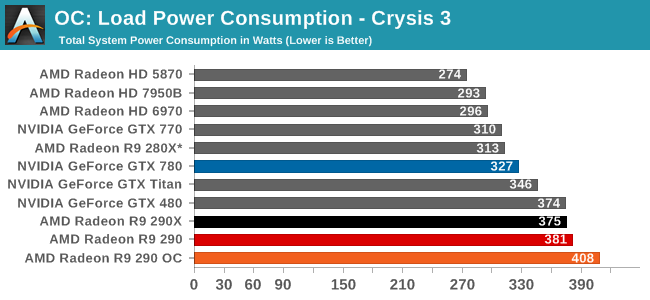
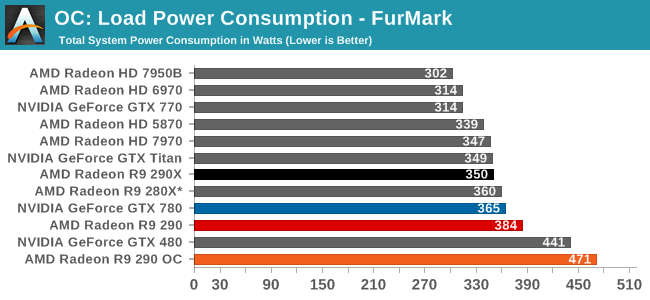
Taking a brief look at power, temp, and noise before jumping into our gaming performance results, we can see that overclocking the card has a measurable impact on power consumption under both Crysis 3 and FurMark. With Crysis 3 we’re clockspeed limited before we’re power limited, leading to an increase in power consumption of 27W, while under FurMark where we were power limited it’s a much more academic increase of 87W.
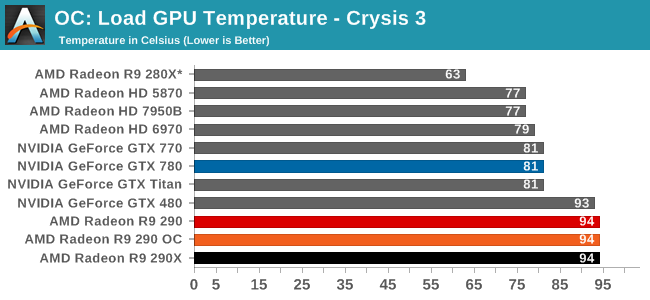
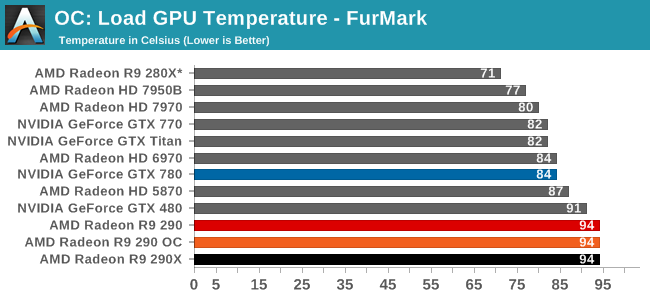
Since the 290 already ships at the highest temperate limit it allows – 95C – our sustained temperatures are unchanged even after overclocking.
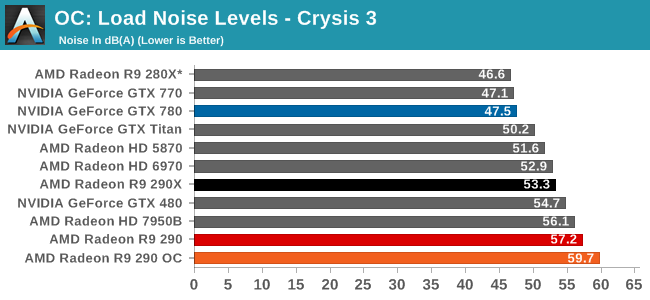
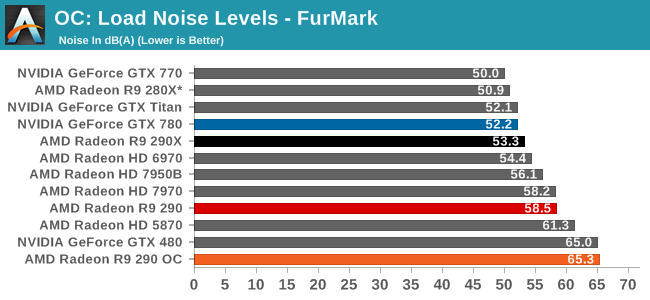
The 290 is already an unreasonably loud card at stock, and unfortunately the fan speed increases needed to handle the greater heat load from overclocking only make this worse. Under Crysis 3 we peaked at 59.7dB, or 49% fan speed. While under FurMark we peaked at 65.3dB, or 59% fan speed. For these noise levels to be bearable the 290 really needs to be fully isolated (e.g. in another room) or put under water, as otherwise 59.7dB sustained is immensely loud for a video card.
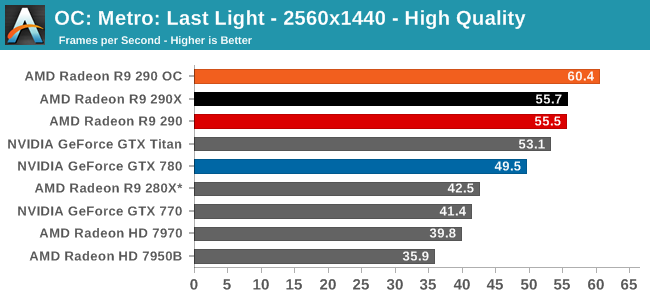
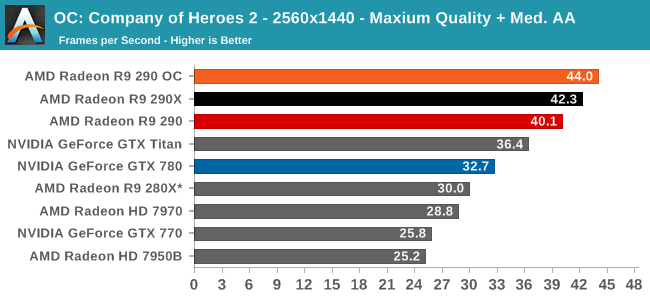
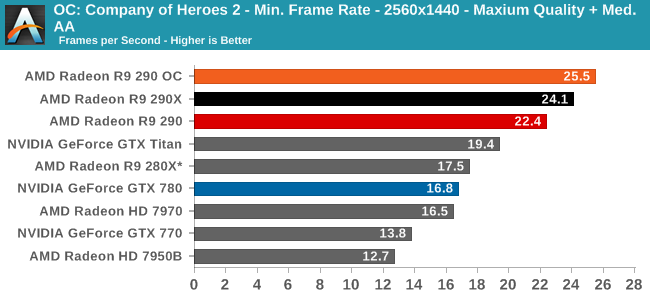
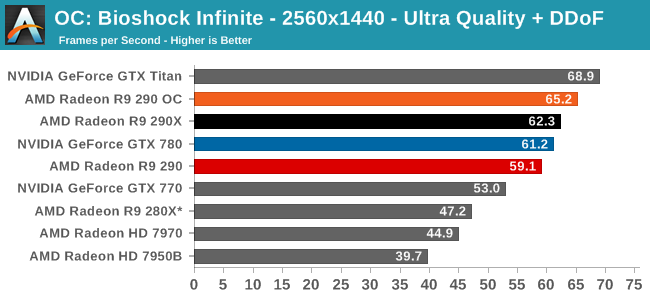
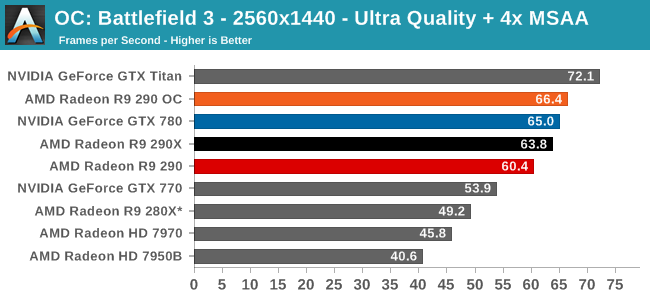
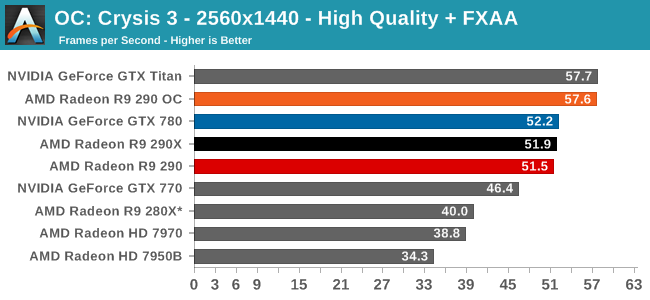
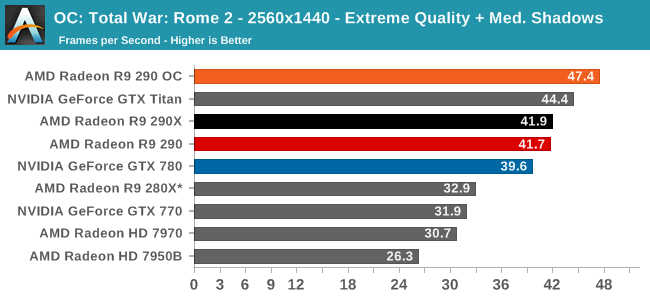
Finally getting to the matter of game performance, we’re seeing consistently strong scaling across every game in our collection. The specific performance increase depends on the game as always, but a 14% core overclock and 12% memory overclock has netted us anywhere between 9% in Metro up to the full 14% in Total War: Rome II. At this performance level the 290 OC exceeds the performance of any other single-GPU card at stock, and comes very close to delivering 60fps in every action game in our benchmark suite.










295 Comments
View All Comments
doggghouse - Wednesday, November 6, 2013 - link
So at 60dB, it's as loud as someone talking next to you. In other words, you would have some difficulty hearing another person over the sound of the GPU fan. I would say that's pretty loud.I think the 290 and 290X have a lot of potential, but with the stock cooling I would stay away from it.
Vorl - Wednesday, November 6, 2013 - link
I don't remember the exact noise test, but I thought the measurement was taken right next to the card, at the fan... so if you put distance, and a case around the card, it will not be nearly as loud as that.ThomasS31 - Wednesday, November 6, 2013 - link
R9 290 series is the worst ever launch for AMD... this was a chance to show how professional they are and gain market share with a great opportunity and product... and they screwed it up and failed.And this is not he first time they failed to monetize their products. So maybe there shall be some personal consequences and changes needed.
Hope the new hires (leaders) change this and this is the last time we saw great products hindered with bad execution.
After the 7990 cooler I and what nVidia did they learned the lessons... but not.
And now as I hear they are not allowing custom coolers and/ or limit manufacturers in the use of the best coolers/design they could do... as competition is bad for market or what???
Mondozai - Friday, December 13, 2013 - link
lolmartixy - Wednesday, November 6, 2013 - link
So the takeaway is:There's a new king in town, and it's name is AMD.
For now...
+You get to be Mantle-proof.
What I wanna see now is Mantle on an nV card and g-sync on an AMD card.
nevertell - Wednesday, November 6, 2013 - link
Why is it so that when a ridiculously loud nvidia card gets released, people go crazy about the heat and noise generated, but when AMD does the same, they only focus on the performance?I do understand that the price and performance for these cards is pretty ground braking, but then again, AMD used to release some nasty adverts about people using Fermi cards. And fermi cards were not even this loud.
And considering the fact that the testbed here was probably properly ventilated and designed for hot and fast cards, I believe there is a significant portion of the market, who will buy the card and stick it into a small or badly ventilated or just crammed case and call it a day. And those people will not be able to get the performance advertised here, as their cards will probably throttle a lot more.
But I do love how the roles are switching, only 3 generations ago, AMD's and Nvidia's positions were exactly the opposite, at least in the power and noise, and mostly power efficiency, departments.
We still have to wait for 780ti, but seeing as titan is already having a run for it's money.
Death666Angel - Wednesday, November 6, 2013 - link
I don't care one bit about the loudness of a card. Anything I own has to be watercooled and the custom water cooling block costs the same whether it is from nVidia or AMD. So this card is a win on all fronts. And unless you have to buy reference design without switching to WC, I don't think you'll be disappointed.It's really hard to read 5 paragraphs on noise when that is the least of anyones concerns when buying a video card. People who are concerned with it have custom cooling stuff which is the same for most cards (nVidia or AMD), since most cards are the same. Or they don't care since their other stuff is louder and/or they use good headphones. So I think knocking the 290 for loudness is a bit petty. :)
Achaios - Wednesday, November 6, 2013 - link
Can't wait for Gigabyte's R9 290 SOC (Super Overclock) with 3X Windforce Cooler. I drool at the thought.ecuador - Wednesday, November 6, 2013 - link
Ryan, it is interesting to contrast this review to Anand's review of the FX 5800. You sound much more damning for a card that is much cheaper and faster than the competition at a 9.7dB louder, than Anand was for a card that was slower and 13dB louder than the competition back then! Ok, it is not for everyone until it gets custom coolers, but it sure gives you a lot for that tradeoff. The mystery is why AMD does not make a cooler that is worth a damn!swing848 - Wednesday, November 6, 2013 - link
Anand,Most people that read your reviews know you are a GeForce fan boy. And, the last page of your "review" tells people not to purchase the R9 290.
In fact, many people purchase this card BECAUSE THEY WANT IT. Let the buyer decide what he or she want in price and performance, and stop poking AMD in they eye with your GeForce stick. If anything give advice to people on how to keep temperatures under control with the least noise possible; but, no, you have to get on your GeForce box and pound AMD ... again. How much do they pay your or your company?
The R9 290 is a great card, and after reading several reviews, know it.